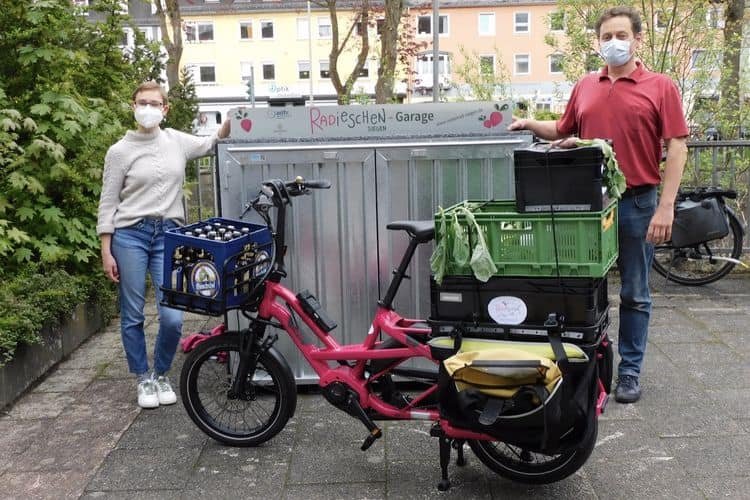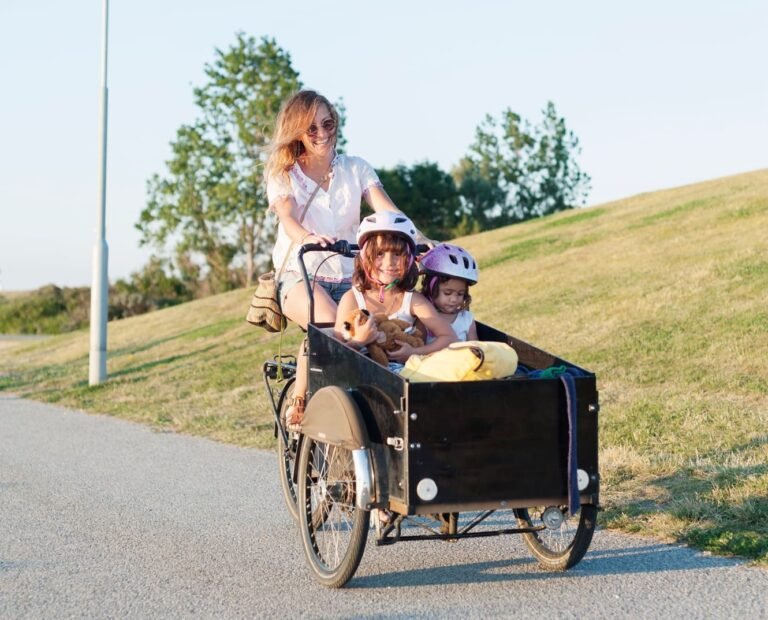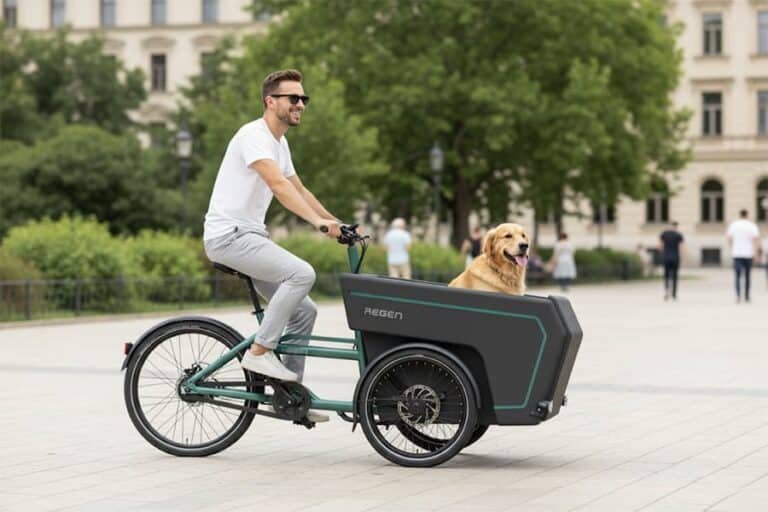Introduktion
I takt med att städerna utvecklas och hållbarhet blir mer än bara ett modeord, får elektriska lastcyklar - eller e-cargo bikes - allt större uppmärksamhet bland familjer, budbärare och till och med lokala myndigheter. Dessa cyklar kombinerar funktionaliteten hos en lastmaskin med effektiviteten hos ett elektriskt drivsystem. De lovar en billiknande användbarhet utan utsläpp, buller eller parkeringsfrustration.
Men för många människor kvarstår frågan: är det verkligen värt att skaffa en elektrisk lastcykel? De kan trots allt vara dyra, tunga och ta upp utrymme. I den här artikeln kommer vi att utforska hur e-cyklar för last fungerar, deras för- och nackdelar och om de verkligen är meningsfulla för din livsstil eller ditt företag.
Vad är en elektrisk lastcykel?
En elektrisk lastcykel är i huvudsak en cykel som är utformad för att bära tyngre laster - oavsett om det är barn, matvaror eller arbetsutrustning - men med extra boost från en elmotor. Medan en vanlig e-cykel hjälper cyklisten att trampa, är en last-e-cykel byggd för att dragkapacitet.
Vanliga konfigurationer inkluderar:
- Cyklar med lång svans - Utrustad med en förlängd bakre pakethållare som kan bära upp till två barn eller flera väskor.
- Cyklar med frontlast (bakfiets) - Placera en lastbox mellan styret och framhjulet, perfekt för barn, husdjur eller skrymmande föremål.
- Midtail-cyklar - En kortare version som balanserar smidighet och lastutrymme.
- Lasttrikes - Trehjuliga versioner ger stabilitet för kommersiella tillämpningar eller tillämpningar med hög belastning.
Regen-redaktionen skrev en blogg om typer av lastcyklar , klicka för att lära dig mer om du är intresserad av.
Dessa cyklar innehåller ofta mittdrivna motorer för bättre vridmoment och balans, förstärkta ramar för strukturell integritet, och batterier med stor kapacitet för att hantera den extra belastningen.
En standardlastcykel kan till exempel ha en 750 W mid-drive motor, a 48 V / 15 Ah batterioch en nyttolastkapacitet över 200 kg - så att du kan transportera två barn, matvaror och några paket på en och samma gång.
Så fungerar elcyklar för gods
Mekaniskt fungerar lastcyklar ungefär som andra elcyklar: en motor ger hjälp när du trampar. Men deras kraftsystem och drivlinor är konstruerade för belastningseffektivitet snarare än bara hastighet.
Motor- och drivsystem
De flesta lastcyklar använder Mittdrivna system (t.ex. Bosch Cargo Line, Shimano EP8 Cargo eller Bafang M620). Dessa motorer driver veven direkt, vilket gör att de kan dra nytta av cykelns växlar för effektiv vridmomentleverans, vilket är särskilt viktigt i branta lutningar eller när man transporterar passagerare.
Batterier och räckvidd
Ett batteri med stor kapacitet - typiskt 500 Wh till 1.000 Wh - avgör hur långt du kan gå mellan laddningarna. Tyngre laster förkortar räckvidden, så många tillverkare erbjuder Alternativ med dubbla batterier för att förlänga resan till 100 km eller mer.
Kontroll- och assistanslägen
Förare kan justera assistansnivåer på en display i styret. Sensorer mäter kadens, vridmoment och hastighet för att ge smidig assistans. Vissa system erbjuder även automatisk växling eller gå assistans för att skjuta upp cykeln på ramper när den är lastad.
Bromsning och stabilitet
Hydrauliska skivbromsar är standard, ofta med större 180-203 mm rotorer för att ge tillräcklig stoppkraft. Stabiliteten förbättras med breda däck, långa hjulbasaroch mittstativ som kan hålla hela lasten upprätt.
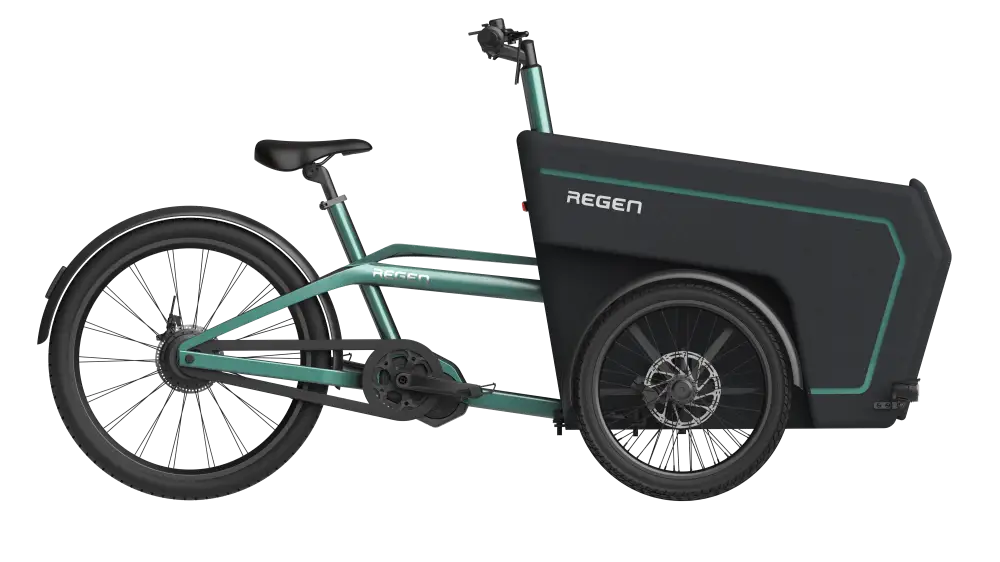

Endast 20 MOQ-cyklar för att komma igång
Anpassningsbar E-Cargo-cykel - RS01
Oavsett om du är ett växande varumärke eller en kvartersbutik är våra kraftiga lastcyklar din biljett in i den blomstrande världen av miljövänliga leveranser. Låt oss rulla!
Fördelarna med elektriska lastcyklar
1. Ersätt bilresor och spara kostnader
Ett av de starkaste argumenten för elcyklar med last är potential för bilersättning. Studier i Europa visar att upp till 60% av bilresor i stadsmiljö är under 5 km (European Cyclists' Federation, 2023). För så korta sträckor kan en lastcykel enkelt klara av de flesta dagliga ärenden.
- Bränslebesparingar: Att ladda ett 700 Wh-batteri kostar mindre än 0,15 euro i många länder - mycket billigare än bensin.
- Underhåll: Inga oljebyten, färre rörliga delar och lägre försäkringskostnader.
- Parkering: Du behöver inte betala för parkering eller leta länge efter en plats.
För småföretag (kurirer, blomsterhandlare, bagerier) kan byte från skåpbilar till e-cargo-cyklar sänka driftskostnaderna samtidigt som leveransflexibiliteten i trafikerade zoner förbättras.
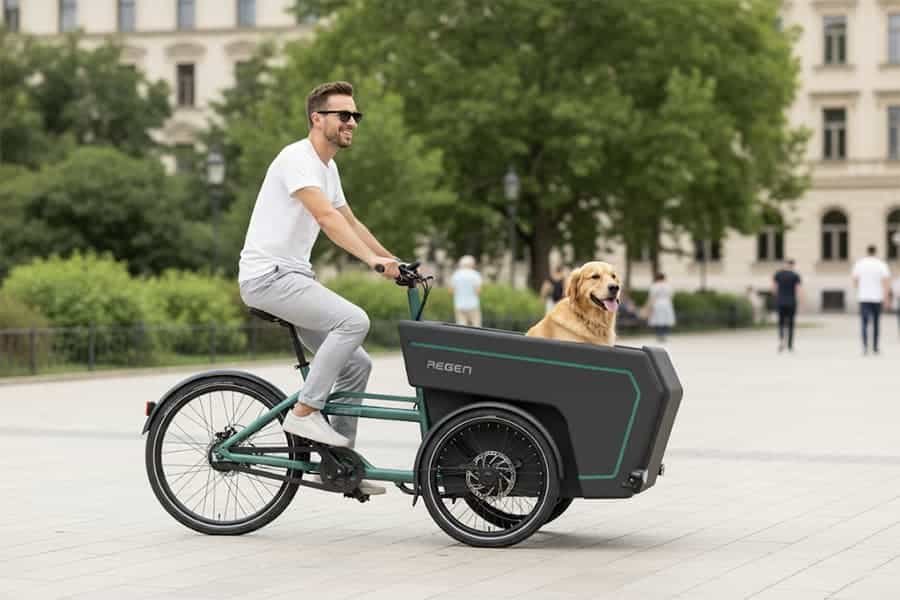
2. Hälsa och motion
Trots elassistansen trampar cyklisterna fortfarande, vilket aktiverar musklerna och förbättrar hjärt-kärlhälsan. Enligt forskning från universitetet i Zürich (2019), Elcyklister förbrukar nästan lika mycket energi som de som cyklar på vanliga cyklar eftersom de reser längre sträckor och åker oftare.
För föräldrar eller pendlare som vill röra på sig men inte orkar med intensiva träningspass erbjuder elcyklar med last en skonsam och jämn träning som kan integreras i de dagliga rutinerna.
3. Fördelar för miljön
Lastcyklar släpper ut Inga utsläpp från avgasröretförbrukar en bråkdel av bilarnas energi och tar upp mindre utrymme. En livscykelstudie från Institute for Transportation and Development Policy (ITDP, 2024) visade att om 15% av bilresorna i städerna ersätts med resor med elcyklar kan koldioxidutsläppen i städerna minska med över 12 miljoner ton per år.
I städer som Paris och Amsterdam, där luftkvalitet och trängsel är akuta problem, är e-lastcyklar en del av långsiktiga hållbarhetsstrategier.
4. Familjevänlig mobilitet
Föräldrar använder i allt högre grad lastcyklar som barntransportörer. Med säkerhetsbälten, väderskydd och justerbara säten är de både säkra och engagerande för barn. Till skillnad från att sitta fastspänd i en bilbarnstol kan barnen interagera, observera staden och njuta av resan.
Många europeiska familjer rapporterar till och med att de har sålt sin andra bil efter att ha skaffat en lastcykel (Urban Arrow & RadWagon ägarundersökningar, 2023).
5. Tillgänglighet och inkludering
Elassistans gör cykling möjlig för dem som annars skulle tycka att traditionella cyklar är för krävande - äldre vuxna, personer med knäproblem eller cyklister i kuperade områden. Den extra kraften gör det också möjligt inkluderande familjeåkningdär varierande konditionsnivåer inte längre begränsar deltagandet.
Nackdelar och utmaningar
Även om fördelarna är betydande bör potentiella köpare vara medvetna om de praktiska avvägningarna.
1. Högre initialkostnad
Kvalitetslastcyklar varierar mellan $3.000 och $10.000 USD, beroende på motorsystem, komponenter och design. Även om långsiktiga besparingar uppväger detta för många, kan den initiala kostnaden avskräcka nya förare.
2. Storlek och vikt
En typisk elcykel för last väger 30-50 kg. Det innebär mer arbete med att förvara, lyfta eller transportera, särskilt om du bor i en lägenhet som inte är tillgänglig från marknivå.
3. Underhåll och batteriskötsel
På grund av belastningsspänningen slits bromsbelägg, däck och drivlinor snabbare. Batterier försämras med tiden (ungefär 20% kapacitetsförlust efter 500 cykler). Årliga avstämningar och korrekta laddningsvanor är avgörande för att maximera livslängden.
4. Risk för stöld
Elcyklarnas höga värde gör dem till stöldobjekt. Säkra lås, GPS-spårare och förvaring i garage rekommenderas starkt.
5. Reglerande variabilitet
Lagarna skiljer sig åt mellan olika regioner. I EU klassificeras de flesta lastcyklar som EPAC (cyklar med elektronisk kraftassistans) under EN 15194 - begränsad till 25 km/h assistanshastighet och 250 W nominell effekt.
I USA beror klassificeringen på delstatslagar:
- Klass 1: Pedalassistans, ≤ 20 mph
- Klass 2: Gaspådragsassistans, ≤ 20 mph
- Klass 3: Pedalassistans, ≤ 28 mph (hjälm krävs i många delstater)
Förare måste kontrollera lokala bestämmelser om hjälmar, passagerarantal eller åldersgränser.
När är det meningsfullt med en elcykel för gods?
Eldrivna lastcyklar passar särskilt bra för vissa livsstilar.
- Urban Families: Perfekt för korta pendlingsavstånd till skola, parker och stormarknader.
- Små företag: Leverantörer, kaféer och rörmokare använder dem för rutter inom staden.
- Pendlare: I kombination med väskor ersätter de en bil för dagliga resor.
- Miljömedvetna hushåll: Familjer som strävar efter att minska bilberoendet och koldioxidutsläppen.
- Fritidscyklister: För dig som gillar weekendresor eller camping och lätt kan bära med dig utrustning.
Om du gör flera korta resor dagligentillbringar mycket tid i trafiken eller kämpar med parkering, kommer en e-lastcykel sannolikt att löna sig både ekonomiskt och känslomässigt.
Kostnads- och ROI-analys
Även om den initiala kostnaden kan verka hög kan den långsiktiga ekonomin vara fördelaktig.
| Föremål | Typisk bil | Cargo elcykel |
|---|---|---|
| Köpeskilling | $25,000 | $5,000 |
| Bränsle/el per 1.000 km | $130 (bensin) | $3-5 |
| Årligt underhåll | $800-1.000 | $150-250 |
| Försäkringar & skatt | $1,000 | Ingen eller minimal |
| Parkering & vägtullar | $500+ | Gratis |
Under fem år kan de totala besparingarna överstiga $20.000 USD - och då är inte miljö- och hälsofördelarna inräknade.
Vissa städer (t.ex. London, Paris, Portland och Berlin) erbjuder till och med köpincitament eller skattelättnader för e-cargo-cyklar, vilket minskar startkostnaden.
Säkerhet och komfort
Säkerhetsdesignen har förbättrats avsevärt:
- Hydrauliska bromsar förkorta stoppsträckan.
- Integrerad belysning och reflektorer säkerställa synlighet.
- Breda stödben håll cyklarna upprätt under lastning.
- Fjädrande sadelstolpar och feta däck förbättra åkkomforten.
- Inhägnader för barn inkluderar ofta 3- eller 5-punktsbälten och regnskydd.
Icke desto mindre bör nya förare öva på att hantera lastade cyklar i ett lugnt område innan du ger dig ut i trafiken. Kontrollera regelbundet däcktryck och bromsfunktion, eftersom stoppsträckan ökar vid belastning.
Hur man väljer rätt lastcykel
- Definiera din huvudsakliga användning. Barntransport, företagsleveranser eller blandad användning?
- Kontrollera lastkapaciteten. Den bör överstiga din totala förväntade last (förare + last).
- Typ av motor. Mid-drive för backar och kraft, hub-drive för enkelhet.
- Batteriets storlek. Sikta på minst 500 Wh; dubbla batterier om den dagliga räckvidden överstiger 60 km.
- Ramgeometri. Låga genomgångsramar förenklar montering och balansering.
- Tillbehör. Säten, ställningar, väderskydd eller släpvagnar ökar användbarheten.
- Stöd efter försäljning. Tillförlitlig service är avgörande för motorsystem och garantianspråk.
Regen rekommenderar att köpare testar flera olika ramtyper och motorsystem före köpet - eftersom komfort och säkerhet varierar kraftigt med belastning och förarens storlek.
Exempel från den verkliga världen
- Amsterdam familjer: Undersökningar visar att 23% av familjer med barn under 12 år nu äger en bakfiets eller e-cargo-cykel, vilket minskar bilanvändningen med 35% (Dutch Cycling Embassy, 2023).
- Köpenhamnskurirer: Stadens pilotprogram ersatte 25 dieselskåpbilar med e-lastcyklar, vilket minskade koldioxidutsläppen med 32 ton per år (Köpenhamns stads transportrapport, 2024).
- Amerikanska hushåll: Portlands "E-Cargo Bike Library" visade att 72% av deltagarna använde sina bilar mindre ofta efter en månads försök.
Dessa exempel visar att el-lastcyklar inte bara är praktiska utan också förändrar stadslivet.
Slutsats: Är det värt att få en elektrisk lastcykel?
För de flesta användare i städer och förorter, ja - en elektrisk lastcykel är absolut värt det. Investeringen ger konkreta fördelar i form av bekvämlighet, kostnadsbesparingar och hållbarhet.
Om du bor i ett bilberoende område med långa pendlingsavstånd och begränsad cykelinfrastruktur är saken inte lika klar. Men i takt med att städerna bygger ut cykelbanor och inför incitament blir lastcyklar snabbt ett realistiskt alternativ för vardagstransporter.
De kommer inte att ersätta varje bilresa - men de testamente ersätter många och gör din mobilitet renare, hälsosammare och ofta roligare.
Referenser
- Köpenhamns stad. (2024). Pilotprojekt för urban logistik: Lastcyklar i stadsleveranser.
- Nederländska cykelambassaden. (2023). Rapport om familjecykling.
- Europeiska cyklistförbundet. (2023). Studie om stadstrafik och bilersättning.
- Institutet för transport- och utvecklingspolitik (ITDP). (2024). Varför vi behöver elcyklar som en klimat- och mobilitetslösning.
- MänniskorFörBikes. (2024). Hälsoeffekterna av elcyklar.
- Universitetet i Zürich. (2019). Pendling med elcykel och fysisk aktivitet.
- USA:s energidepartement. (2023). Jämförelse av energiförbrukningen för elcyklar.
- Urban Arrow & RadWagon. (2023). Användarundersökning om bilbytesbeteende.
- Wikipedia. (2025). Elektrisk cykel.
- Harvard Health Publishing. (2024). Elcyklarnas popularitet och säkerhetsproblem.



